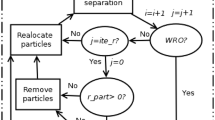Abstract
This work presents a particle packing method based on a distance minimization procedure with non-uniform sizes and prescribed filling ratio. In the study of engineering problems involving granular systems, like those that employ numerical tools such as the discrete element method, an important modeling task is to produce the initial geometric configuration for a given set of particles. Several methods of particle packing are currently employed for this purpose. In this work, the employed methodology uses the Levenberg–Marquardt minimization strategy and does not require a mesh to generate the initial geometric configuration for the particle set. Also, the technique aims a good approximation for the input parameters of granular media, such as grain size distribution and filling ratio. The proposed methodology is divided into four macro-steps: (a) definition of the initial particle assembly, (b) distance minimization procedure, (c) particle reallocation and d) particle removal. The input data related to the size distribution and filling ratio are used to generate the initial particle assembly, and the following steps are used to eliminate the overlapping between the circles. The packing algorithm presents good computational performance and converges to the input parameters. Granular models generated from real soil data are presented for validation of the proposed strategy.











Similar content being viewed by others
References
Cundall PA, Strack ODL (1979) Discrete numerical-model for granular assemblies. Geotechnique 29(1):47–65
Campbell CS, Cleary PW, Hopkins M (1995) Large-scale landslide simulations–global deformation, velocities and basal friction. J Geophys Res Solid Earth 100(B5):8267–8283
Brown K, Attaway S, Plimpton S, Hendrickson B (2000) Parallel strategies for crash and impact simulations. Comput Methods Appl Mech Eng 184(2–4):375–390
Onate E, Rojek J (2004) Combination of discrete element and finite element methods for dynamic analysis of geomechanics problems. Comput Methods Appl Mech Eng 193(27–29):3087–3128
Chang KJ, Taboada A (2009) Discrete element simulation of the Jiufengershan rock-and-soil avalanche triggered by the 1999 Chi-Chi earthquake, Taiwan. J Geophys Res Earth Surf
Mechtcherine V, Gram A, Krenzer K, Schwabe JH, Bellman C, Shyshko S (2014) Simulation of fresh concrete flow, vol 15, 1 edn. Springer,
Liu LF, Zhang ZP, Yu AB (1999) Dynamic simulation of the centripetal packing of mono-sized spheres. Phys A 268(3–4):433–453
Siiria S, Yliruusi J (2007) Particle packing simulations based on Newtonian mechanics. Powder Technol 174(3):82–92
Baugh Jr., Konduri RKS (2001) Discrete element modelling on a cluster of workstations. Eng Comput 17
Cintra DT, Willmersdorf RB, Lyra PRM, Lira WWM (2016) A hybrid parallel dem approach with workload balancing based on hsfc. Emerald Insight 33(1):C96–C126
Cui L, O’Sullivan C (2003) Analysis of a triangulation based approach for specimen generation for discrete element simulations. Granular Matter 5(3):135–145
Frery A, Rivarola-Duarte L, Ramos V, Ramos A, Lira W (2011) Stochastic particle packing with specified granulometry and porosity. Granular Matter, pp 1–10
Feng YT, Han K, Owen DRJ (2003) Filling domains with disks: an advancing front approach. Int J Numer Meth Eng 56(5):699–713
Han K, Feng YT, Owen DRJ (2005) Sphere packing with a geometric based compression algorithm. Powder Technol 155(1):33–41
Labra C, Onate E (2009) High-density sphere packing for discrete element method simulations. Commun Numer Methods Eng 25(7):837–849
Levenberg K (1944) A method for the solution of certain problems in least squares. Quart Appl Math 2:164–168
Marquardt DW (1963) An algorithm for least-squares estimation of nonlinear parameters. SIAM J Appl Math 11(2):431–441
Munjiza A, Andrews KRF (1998) Nbs contact detection algorithm for bodies of similar size. Int J Numer Meth Eng 43(1):131–149
Williams JR, Perkins E, Cook B (2004) A contact algorithm for partitioning arbitrary sized objects. Eng Comput: Int J Comput Aided Eng, pp 235–248
Krumbein WC (1937) The sediments of barataria bay. J Sediment Petrol 7:3–17
Udden JA (1914) Mechanical composition of clastic sediments. Geol Soc Am Bull 22:281–680
Acknowledgements
The authors thank FAPEAL for their support and funding in research and PETROBRAS for the development of projects that have resulted in this work.
Author information
Authors and Affiliations
Corresponding author
Additional information
Publisher's Note
Springer Nature remains neutral with regard to jurisdictional claims in published maps and institutional affiliations.
Rights and permissions
About this article
Cite this article
Lopes, L.G.O., Gouveia, L.P., Cintra, D.T. et al. A particle packing method for non-uniform sizes and prescribed filling ratio. Engineering with Computers 37, 3003–3015 (2021). https://doi.org/10.1007/s00366-020-00990-4
Received:
Accepted:
Published:
Issue Date:
DOI: https://doi.org/10.1007/s00366-020-00990-4




